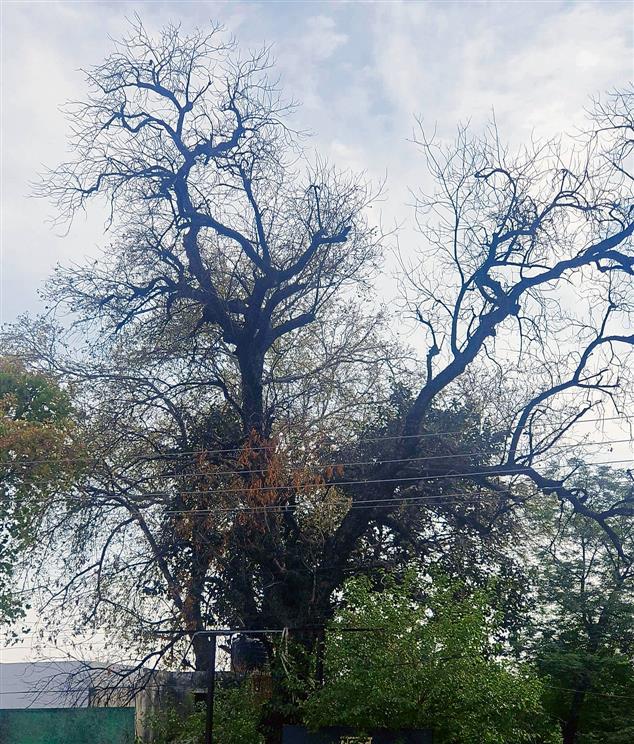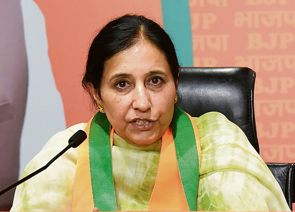
Dry neem trees in Patiala on Tuesday. TRIBUNE PHOTO: RAJESH SACHAR
Aman Sood
Patiala, April 9
Punjab’s real native, the ‘neem trees’ are exhibiting an oddly withered appearance across Punjab and ever since the winter months, the trees are not returning back to normal with twigs and leaves of neem trees drying further. While the Forest Department has raised the issue and are conducting some surveys to study the problem, the environmentalists blame ‘climate change’.
NATURAL PESTICIDE
Ironically, neem that has become synonymous with providing good health to other trees, animals and people through its twigs, leaves, flowers, bark, seeds and fruits, has been dying across the state. An expert from the Forest Department confirmed that neem tree, which is considered a natural pesticide, is now itself a victim of pest and fungus due to the drying of leaves since the past few weeks.
Harsh winters behind phenomenon
There was a phase when for 48 days at a stretch, the trees were without sunlight for most part of the day. Less frost and more foggy days meant that the maximum temperatures for the most winter days were around six degrees as compared to an average 12 degrees. This was also the culprit. — GPS Dhillon, Head of Department of Forestry and Natural Resources, Punjab Agriculture University
Wild animals benefit from neem
Not only monkeys and langurs, but also the antelopes and birds depend on neem trees due to health benefits. Dry trees attract disease and it has infected neem trees of all sizes and ages. It causes twig blight in neem, which means that fruit production falls drastically affecting birds, animals and rural communities. — Jaskaran Sandhu, former member of Punjab State Board for Wildlife University
According to field officers of the Agriculture and Forest Department across Punjab, the prolonged winter spell, not seen in the past over four decades, has led to neem trees being affected by defoliation which dries up of the entire canopy and ultimately the tree dies in a course of time.
“In many villages and our birs (forest protected areas), the trees are still dry. Normally, the leaves of trees turn yellow during peak winter months and then gradually begin to fall, but at the same time, new shoots start to emerge. However, these days, the neem trees are still drying further, raising concern,” a forest official said.
Drying of neems was a cause of worry for the wildlife experts too, who said that many wild animals depend on neem leaves and their twigs to remain healthy in the foothills and also inside the birs. “Not only monkeys and langurs, but also the antelopes and birds depend on neem trees for health benefits,” said Jaskaran Sandhu, a former member of Punjab State Board for Wildlife. “Dry trees always attract disease and fungus and it has infected neem trees of all sizes and ages. Apart from fruit rot, it causes twig blight in neem which means that fruit production falls drastically affecting birds, animals and rural communities who are economically dependent on neem seed,” Sandhu added.
The drying up of twigs and leaves of neem trees has become a familiar sight in many parts of Punjab over the last few weeks.
Ironically, neem that has become synonymous with providing good health to other trees, animals and people through its twigs, leaves, flowers, bark, seeds and fruits, has been dying across the state. An expert from the Forest Department confirmed that neem tree — which is considered a natural pesticide — is now itself a victim of pest and fungus due to the drying of leaves since the past few weeks.
“The younger and stronger neem trees have survived the attack. In our nurseries maintained by the Forest Department, the saplings and the younger trees were taken care of and they have survived this strange phenomenon. Things are getting better with more sunny days and some rain,” said a senior Forest Department official, preferring anonymity.
In this regard, Head of Department of Forestry and Natural Resources, Punjab Agriculture University GPS Dhillon told The Tribune that this winter was very different and the sunny days were the least. “There was a phase when for 48 days at a stretch, the trees were without sunlight for most part of the day. Less frost and more foggy days meant that the maximum temperatures for the most winter days were around six degrees as compared to an average 12 degrees. This was also the culprit,” he stated, adding that 20 per cent of the trees will not revive in Punjab, which were already weak or affected by some disease.
“However the other 80 per cent of the trees are slowly getting back to normal and with good sunny days and rains ahead, they will bloom again. Trees should be back to normal healthy state in another two weeks from now,” Dhillon added.
When contacted, Principal Chief Conservator of Forests (HoFF) RK Mishra said, “It was due to severe and long cold this year. Most of them has now rejuvenated in spring”.
Join Whatsapp Channel of The Tribune for latest updates.




























